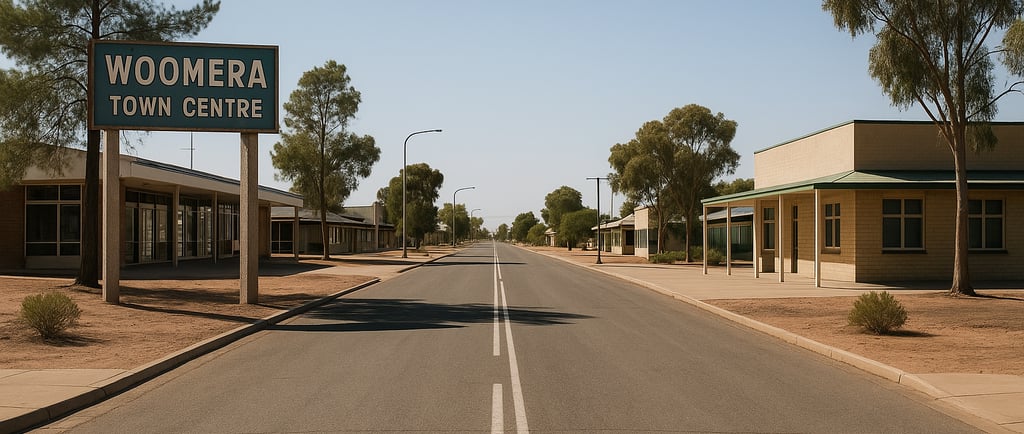Woomera: Past, Present, and Pathways to Reintegration
Once a top-secret missile testing site and Cold War hub, Woomera stands as a unique chapter in Australia’s history. This blog post traces its evolution from military stronghold to near-abandoned township and explores current opportunities for reintegration into regional life. With existing infrastructure, strategic location, and historical significance, Woomera holds untapped potential. We examine revitalisation pathways that could transform this iconic site into a thriving centre for innovation, community, and industry.
REMOTE LIFE
7/26/20253 min read


Woomera, situated about 450 km northwest of Adelaide in South Australia, stands as a testament to Australia’s Cold War heritage, aerospace prowess, and contemporary challenges. This blog post delves into Woomera’s origins, its current underutilisation, proposed revitalisation plans, and government initiatives aimed at reintegrating the township into regional life.
1. Founding & Cold War Apex
Establishment and purpose
Established in 1947 under the Anglo-Australian Joint Project, Woomera was designed as a top-secret weapons testing site—declared a Prohibited Area in December 1947—used to test long-range missiles, sounding rockets, and nuclear devices under strict secrecy.¹
Community growth
At its peak (1950s–1960s), the Village housed up to 7,000 residents—a blend of military, engineers, families, and support staff. The nearby Nurrungar USAF-Australian satellite tracking station (1969–1999) maintained around 4,500 people, keeping Woomera populous even as missile programs wound down.²
Landmark aerospace moments
Woomera saw 518 rocket launches, including the UK’s Black Knight and Blue Streak and NASA’s Skylarks. Notably, Australia launched its first satellite (WRESAT) here in 1967, with Japan’s Hayabusa probes landing through the range in 2010 and 2020.³
2. Transition & Under‑utilisation
Post-Cold War decline
After the Joint Project ended circa 1980, the Village population collapsed. Although bolstered temporarily by Nurrungar, numbers dwindled after its closure in 1999. The controversial Woomera Immigration Detention Centre (1999–2003) briefly revived activity, but closed by early 2003, leaving many facilities deserted.⁴
Today’s profile
Woomera Village now supports around 146–200 permanent residents, though daily military activity can push occupancy to 500. Besides serving as base support, Woomera functions primarily as a heritage site—home to the Aerospace & Missile Park, Heritage Centre, observatory, and RSL and social clubs.⁴
Under‑utilisation
Non-Defence use is limited: public access is confined mostly to the Village. Underground mines and pastoral leases pepper the WPA, but broader economic integration remains minimal. Despite 60,000–70,000 tourist visits per year, the community lacks diverse economic activities.⁴
3. Redevelopment Proposals & Community Vision
A. Defence Infrastructure Enhancement
In 2016, a $297 million upgrade was announced to modernise monitoring systems and support next-gen Defence trials, including F‑35 aircraft. Ongoing redevelopment includes refurbishing hangars, power, sewage, communications, and accommodation. Construction is slated from 2027 to 2034.⁵
B. Tourism & Heritage Activation
Woomera's mid-century architecture, vehicle testing narratives, and Len Beadell's legacy present rich tourism possibilities. Proposals include heritage walking trails, living-history events, and indigenous cultural tours.⁴
C. Mining & Agribusiness Co‑existence
Under 2011 federal-state pacts, portions of the WPA were opened to mining, guided by a coexistence framework with access zones. A 2017 economic assessment noted significant mineral value.⁶
D. Water Security & Environmental Sustainability
The Northern Water Project plans a sustainable water supply network across Far North SA—including Woomera—supporting population resilience and potential economic growth.⁷
4. Government & Strategic Initiatives
Federal Defence Investments
The RAAF-led Woomera Redevelopment Program (2027–2034) revitalises base infrastructure to support ADF and allies.⁵
Independent Review
In August 2024, the Albanese government initiated an independent review of WPA policies to ensure balance between national security, civil access, and regional opportunity.⁸
State Prosperity Strategy
The 2024 SA Government State Prosperity Project supports frameworks like WPA Coexistence to align mining, defence, and tourism with regional economic growth.⁸
5. Reintegration: A Roadmap to Renewal
• Leverage heritage tourism: expand on museum offerings, astronomy nights, and Len Beadell trails.
• Diversify local services: activate remaining housing for contractors, tourism, or small business.
• Enable co-use access: build on mining coexistence models to welcome compatible industries.
• Upgrade sustainability infrastructure: integrate water security, power, and communications upgrades.
• Engage First Nations: include Kokatha stakeholders in heritage tours and land management within WPA.
6. Conclusion
From a Cold War epicentre now reduced to a defence-backed hub and heritage waypoint, Woomera possesses latent potential. Strategic investment in infrastructure, tourism, mining, environment, and community could shift Woomera from underused relic to vibrant regional node.
By aligning Defence upgrades with sustainable economic activation and cultural engagement, Woomera can truly reintegrate—honouring its history, empowering its present, and envisioning a resilient future.
Footnotes
1. https://en.wikipedia.org/wiki/Woomera,_South_Australia
2. https://en.wikipedia.org/wiki/RAAF_Woomera_Range_Complex
3. https://countryairstrips.com.au/listing/woomera-south-australia/
4. https://en.wikipedia.org/wiki/Woomera,_South_Australia
5. https://defenceconnect.com.au
6. https://www.energymining.sa.gov.au/woomera-prohibited-area


Far North Consulting Pty Ltd t/a Groundwork Consulting
© 2025 Groundwork Consulting
ABN 77 649 525 806
MAKING GOOD IDEAS WORK
Video Platform Links





